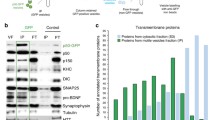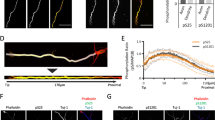Abstract
1.To study proteins transported with actin in axons, we pulse-labeled motoneurons in the chicken sciatic nerve with [35S]methionine and, 1–20 days later, isolated actin and its binding proteins by affinity chromatography of Triton soluble nerve extracts on DNase I–Sepharose. The DNase I-purified proteins were electrophoresed on two-dimensional gels and the specific activity of the radioactively labeled protein spots was estimated by fluorography.
2.In addition to actin, which binds specifically to DNase I, a small number of other proteins were labeled, including established actin monomer binding proteins and a protein of 36 kDa and pI 8.5. On the basis of its molecular mass, pI, amino acid composition, and immunostaining, the unrecognized protein was identified as the glycolytic enzyme glyceraldehyde-3-phosphate dehydrogenase (GAPDH).
3.The high-affinity binding of GAPDH to actin was confirmed by incubation of Triton-soluble nerve extracts with either mouse anti-GAPDH (or antiactin) and indirect immunomagnetic separation with Dynabeads covalently linked to sheep anti-mouse antibody. Analysis by one-dimensional gel electrophoresis and immunoblotting showed that actin and GAPDH were the main proteins isolated by these methods.
4.Analysis of labeled nerves at 12 and 20 days after pulse labeling showed that GAPDH and actin were transported at the same rate, i.e., 3–5 mm/day, which corresponds to slow component b of axonal transport. These proteins were not associated with rapidly transported proteins that accumulated proximal to a ligation 7 cm from the spinal cord 9 hr after injection of radioactivity.
5.Our results indicate that GAPDH and actin are transported as a complex in axons and raise the possibility that GAPDH could act as a chaperone for monomeric actin, translocating it to intraaxonal sites for exchange with or assembly into actin filaments. Alternatively, actin could be involved in translocating and anchoring GAPDH to specialized sites in axons and nerve terminals that require a source of ATP by glycolysis.
Similar content being viewed by others
REFERENCES
Allen, R. W., Trach, K. A., and Hoch, J. A. (1987). Identification of the 37-kDa protein displaying a variable interaction with the erythroid cell membrane as glyceraldehyde-3-phosphate dehydrogenase. J. Biol. Chem. 262:649–653.
Bamburg, J. R., and Bernstein, B. W. (1991). Actin and actin-binding proteins in neurons. In Burgoyne, R. D. (ed.), The Neuronal Cytoskeleton, J. Wiley and Sons, New York, pp. 121–160.
Bamburg, J. R., Minamide, L. S., Morgan, T. E., Hayden, S. M., Guiliano, K. A., and Koeffer A. (1991). Purification and characterisation of low-molecular weight actin depolarising proteins from brain and cultured cells. Methods Enzymol. 196:125–140.
Bass, P. W., and Brown, A. (1997). Slow axonal transport: The polymer transport model. Trends Cell Biol. 7:380–384.
Brady, S. T., and Lasek, R. J. (1981). Nerve-specific enolase and creatine phosphokinase in axonal transport: Soluble proteins and the axoplasmic matrix. Cell 23:515–523.
Burke, J. R., Enghild, J. J., Martin, M. E., Jou, Y.-S., Myers, R. M., Roses, A. D., Vance, J. M., and Strittmatter, J. (1996). Huntingtin and DRPLA proteins selectively interact with the enzyme GAPDH. Nature Med. 2:347–350.
Dimmeler, S., Lottspeich, F., and Brüne, B. (1992). Nitric oxide causes ADP-ribosylation and inhibition of glyceraldehyde-3-phosphate dehydrogenase. J. Biol. Chem. 267:16771–16774.
Füchtbauer, A., Jockusch, B. M., Leberer, E., and Pette, D. (1986). Actin-severing activity copurifies with phosphofructokinase. Proc. Natl. Acad. Sci. USA 83:9502–9506.
Grafstein, B., and Forman, D. S. (1980). Intracellular transport in neurons. Physiol. Rev. 60:1167–1283.
Hirokawa, N. (1993). Axonal transport and the cytoskeleton. Curr. Opin. Neurobiol. 3:724–731.
Hirokawa, N., Terado, S., Funakoshi, T., and Takeda, S. (1997). Slow axonal transport: the subunit transport model. Trends Cell Biol. 7:384–388.
Hobohm, U., Houthaeve, T., and Sander, C. (1994). Amino acid analysis and protein database composition search as a fast and inexpensive method. Anal Biochem. 222:202–209.
Hsu, S. C., and Molday, R. S. (1990). Glyceraldehyde-3-phosphate dehydrogenase is a major protein associated with the plasma membrane of retinal photoreceptor outer segments. J. Biol. Chem. 265:13308–13313.
Ishitani, R., Sunaga, K., Hirano, A., Saunders, P., Katsube, N., and Chuang, D.-M. (1996). Evidence that glyceraldehyde-3-phosphate dehydrogenase is involved in age-induced apoptosis in mature cerebellar neurons in culture. J. Neurochem. 66:928–935.
Kawamoto, R. M., and Caswell, A. H. (1986). Autophosphorylation of glyceraldehydephosphate dehydrogenase and phosphorylation of protein from skeletal muscle microsomes. Biochemistry 25:656–661.
Knull, H. R. (1980). Compartmentation of glycolytic enzymes in nerve endings as determined by glutaraldehyde fixation. J. Biol. Chem. 255:6439–6444.
Kumagai, H., and Sakai, H. (1983). A porcine brain protein (35k protein) which bundles microtubules and its identification as glyceraldehyde 3-phosphate dehydrogenase. J. Biochem. 93:1259–1269.
Lanzara, V., and Grazi, E. (1987). On an Mg2+-dependent interaction of actin with glyceraldehydephosphate dehydrogenase. FEBS Lett. 221:387–390 (1987).
Lasek, R. J., Garner, J. A., and Brady, S. T. (1984). Axonal transport of the cytoplasmic matrix. J. Cell Biol. 99(Suppl.):212s-221s.
Maekawa, S., Nishida, E., Ohata, Y., and Sakai, H. (1984). Isolation of low molecular weight actin-binding proteins from porcine brain. J. Biochem. 95:377–385.
Masters C. (1984). Interactions between glycolytic enzymes and components of the cytomatrix. J. Cell Biol. 99:222s-225s.
Méjean, C., Pons. F., Benyamin, Y., and Roustan, C. (1989). Antigenic probes locate binding sites for the glycolytic enzymes glyceraldehyde-3-phosphate dehydrogenase, aldolase and phosphofructokinase on the actin monomer in microfilaments. Biochem. J. 264:671–677.
Mills, R. G., Minamide, L. S., Yuan, A., Bamburg, J. R., and Bray, J. J. (1996). Slow axonal transport of soluble actin with actin depolymerizing factor, cofilin and profilin suggests actin moves in an unassembled form. J. Neurochem. 67:1225–1234.
Morrissey, J. H. (1981). Silver stain for proteins in polyacrylamide gels: A modified procedure with enhanced uniform sensitivity. Anal. Biochem. 117:307–310.
Muronetz, V. I., Wang, Z.-X., Keith, T. J., Knull, H. R., and Srivastava, D. K. (1994). Binding constants and stoichiometries of glyceraldehyde 3-phosphate dehydrogenase-tubulin complexes. Arch. Biochem. Biophys. 313:253–260 (1994).
Nixon, R. A. (1998). The slow axonal transport of cytoskeletal proteins. Curr. Opin. Cell Biol. 10:87–92.
Panabières, F., Piechaczyk, M., Rainer, B., Dani, C., Fort, P., Riaad, S., Marty, L., Imbach, J. L., Jeanteur, P., and Blanchard, J. M. (1984). Complete nucleotide sequence of the messenger RNA coding for chicken muscle glyceraldehyde-3-phosphate dehydrogenase. Biochem. Biophys. Res. Commun. 118:767–773.
Robbins, A. R., Ward, R. D., and Oliver, C. (1995). A mutation in glyceraldehyde 3-phosphate dehydrogenase alters endocytosis in CHO cells. J. Cell Biol. 130:1093–1104.
Rogalski-Wilk, A. A., and Cohen, R. S. (1997). Glyceraldehyde-3-phosphate dehydrogenase activity and F-actin associations in synaptosomes and postsynaptic densities of porcine cerebral cortex. Cell. Mol. Neurobiol. 17:51–70.
Sawa, A., Khan, A. A., Hester, L. D., and Snyder, S. H. (1997). Glyceraldehyde-3-phosphate dehydrogenase: Nuclear translocation participates in neuronal and nonneuronal cell death. Proc. Natl. Acad. Sci. USA 94:11669–11674.
Sirover, M. A. (1997). Role of glycolytic protein, glyceraldehyde-3-phosphate dehydrogenase, in normal cell function and in cell pathology. J. Cell. Biochem. 66:133–140.
Wu, K., Aoki, C., Elste, A., Rogalski-Wilk, A. A., and Siekevitz, P. (1997). The synthesis of ATP by glycolytic enzymes in the postsynaptic density and the effect of endogenously generated nitric oxide. Proc. Natl. Acad. Sci. USA 94:13273–13278.
Yuan, A., Mills, R. G., Bamburg, J. R., and Bray, J. J. (1997). Glyceraldehyde-3-phosphate dehydrogenase is bound to actin in slow axonal transport. Mol. Biol. Cell 8(Suppl.):368a.
Zhang, J., and Snyder, S. H. (1992). Nitric oxide stimulates auto-ADP-ribosylation of glyceraldehyde-3-phosphate dehydrogenase. Proc. Natl. Acad. Sci. USA 89:9382–9385.
Author information
Authors and Affiliations
Rights and permissions
About this article
Cite this article
Yuan, A., Mills, R.G., Bamburg, J.R. et al. Cotransport of Glyceraldehyde-3-Phosphate Dehydrogenase and Actin in Axons of Chicken Motoneurons. Cell Mol Neurobiol 19, 733–744 (1999). https://doi.org/10.1023/A:1006953022763
Issue Date:
DOI: https://doi.org/10.1023/A:1006953022763




